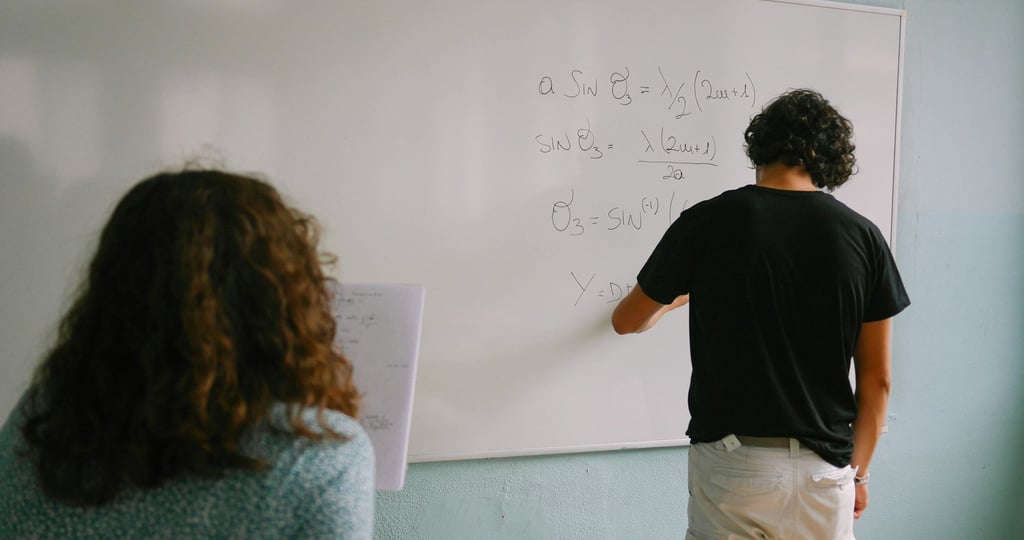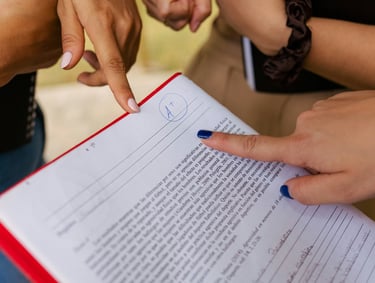9 Exam Taking Tips to ACE Your Next IGCSE Math Exam
Preparation alone isn’t enough. Learn 9 proven Exam Taking Tips to help you score higher in your next IGCSE or Cambridge Maths exam.
STUDENTS
Achiever Tandoh
6/20/202511 min read




You’ve studied. You’ve revised. You’ve solved past papers. You’ve even memorised formulas and practiced different types of questions. So why is it that when the actual IGCSE Maths exam begins you often find yourself blanking out? Or rushing through questions and making avoidable mistakes? Or worse, walking out thinking you did well only to realise later that you lost marks on things you knew? You lost marks on questions you could've nailed!
This scenario plays out far too often. And the reason might surprise you.
Many students don’t underperform in Cambridge Maths because they don’t understand the material. They underperform because they don’t know how to take the exam effectively.
Yes, there’s a difference between studying and showing what you know in a high-pressure exam room. That difference is what this blog post is all about.
If you’re preparing for your IGCSE Math Exam—or any Cambridge Math Exam—you need to understand this: Proper preparation alone is not enough. If you want to maximise your performance and walk out of that exam room with the marks you deserve, you need to learn how to take the exam strategically.
In this post, I’ll explore 10 proven exam taking tips that are tailored specifically for Cambridge Maths. These are actionable techniques that can make a measurable difference in your performance on the day of the exam.
The Difference Between Preparation and Performance
Let’s make one thing clear right from the start:
Studying hard ≠ Performing well
You can spend weeks going through past papers, flashcards, and topic notes. But when that exam clock starts ticking, something else takes over—your ability to apply that knowledge under pressure.
In Cambridge Maths, it’s not enough to just know how to do algebra, geometry, or statistics. You have to:
Understand exactly what the question is asking
Avoid panic when a problem looks unfamiliar
Manage your time across questions of varying difficulty
Present your working in a way that earns every possible method mark
Avoid small, silly errors that cost you marks
All of this comes down to one thing: exam technique. It’s a skill. And like all skills, it can be learned, practiced, and mastered.
If you’ve been putting all your effort into content revision, that’s excellent—but now it’s time to take it further. It’s time to master how to take the exam itself.
9 Exam Taking Tips to ACE Your Next IGCSE Math Exam


Tip 1: Read the Instructions—Twice
This might seem basic. But trust me, it’s one of the most overlooked sources of lost marks.
Every year, students lose marks not because they didn’t know the content, but because they didn’t read the instructions properly. Let’s look at a few real-life examples:
The paper says: "Answer 3 out of 5 questions." You answer all 5, wasting time on questions that won’t even be marked.
The question says: "Give your answer in 3 significant figures." You round to 2 decimal places.
The paper specifies: "Use π = 3.142." You use the π button on your calculator instead.
Cambridge examiners are precise, and they expect you to follow instructions exactly. These small mistakes may seem insignificant, but they could mean the difference between a grade boundary—especially in high-stakes papers like IGCSE, AS or A-Level.
You’ve already done the hard part which is learning the content. But marks are awarded based on how you follow the rules of the exam, not just how much you know. Misreading an instruction is like running the wrong direction in a race. You may have all the energy and be as fast as a cheetah, but you won’t get to the finish line.
Spend the first 2–3 minutes of the exam scanning the entire paper:
Look for pages where options are given (e.g. "Answer any 2 questions from Section B")
Underline instruction keywords: “Give your answer in…”, “Show all working…”, “Estimate…”, etc.
Mentally note any formatting expectations
Not only does this help you avoid careless errors, but it also helps to slow down your breathing, calms your nerves, and sets the tone for a focused, intentional exam session. Who doesn’t want that?
Tip 2: Start With What You Know


The first 10–15 minutes of your exam set the tone for your performance. So, start strong. Don’t try to prove a point by going straight into the hardest question. This is not the time to flex your math muscles, it’s time to build confidence and momentum.
Begin by skimming through the paper. Identify which questions look straightforward, these are usually from topics you’ve mastered or formats you’ve practiced multiple times.
Why start here? Because:
It helps you build momentum early
You secure easy marks quickly
It calms your nerves and boosts confidence
It gets your brain "warmed up" for the tougher problems ahead
At Chimhanda Tutoring, we encourage our students to apply the Easy → Medium → Hard strategy. That means:
Complete the easy, familiar questions first (your confidence boosters)
Move on to the medium-difficulty ones next (you might need to think a bit)
Tackle the hardest ones last (now that you're in full exam flow)
By doing this, you’re not just solving problems randomly, you’re playing to your strengths and taking control of the exam.
Tip 3: Allocate Time by Marks, Not Questions
You’ve probably heard “manage your time wisely.” But here’s how to do it correctly:
Don’t divide your time based on the number of questions—divide it based on marks.
Let’s break this down:
Suppose your paper is 120 minutes long and worth 100 marks.
That gives you about 1.2 minutes per mark.
So how long should you allocate for a 10-mark question? Aim to spend no more than 12 minutes.
But many students make this mistake: they spend 20 minutes stuck on one difficult question that's worth 5 marks, trying to “figure it out,” and end up rushing through a longer, more valuable question at the end.
That’s not a smart exam strategy.
Time is a resource in the exam room and every minute should be invested wisely. If a question seems to throw you off, don't waste too much time trying to figure it out. Make a note on it and move on. In other words, if a question is taking you too long:
✅ Flag it ✅ Move on ✅ Return later
Remember: You’re not required to solve every question in order. Your goal is to maximize your total marks, not to finish the paper perfectly from top to bottom.
Use your watch or the wall clock to pace yourself. If the paper is divided into sections, give yourself time budgets for each.
Even better: Do timed mock papers during revision. That way, time awareness becomes second nature.
Tip 4: Show All Your Working


This tip cannot be overstated. Cambridge Maths papers award method marks, and that means how you get your answer is just as important, sometimes more important, than the final answer itself.
If you skip the steps and only write down the final answer, you’re essentially telling the examiner, “Trust me, I know what I’m doing.” But if that final answer is wrong, even slightly, you’ve lost the whole value of the question.
However, if you show your process and something goes wrong near the end, you may still earn most of the marks for your correct method.
This also applies to skipping specific steps. Sometimes you know you could solve a question in fewer steps but doing so might rob you of potential partial marks. For example, if you skipped a few steps and make a mistake down the road and get a wrong final answer, then you lose partial marks for the steps you skipped.
Here’s how to show your working effectively:
Lay out steps clearly and logically
Use proper notation and formulae
Label units and conversions
Box your final answers
Even if you’re unsure about the final step, write what you know. You might end halfway there, and that’s still worth partial marks.
Think of showing your work, like narrating your thinking. It allows the examiner to reward you for what you understand, not just penalise you for what you missed.
At Chimhanda Tutoring, we call this "mark-scavenging”, you hunt for every possible mark, not just the ones at the end of the question.
You might encounter a certain 10-mark question that you find really challenging, that doesn't mean you shouldn't attempt it. It's better to try as hard as you can to get a few of those marks provided you have time.
Tip 5: Don’t Panic


Most often than not, there’s almost always that question, the one that completely throws you off regardless of ho much you prepared.
Maybe it’s worded in a weird way.
Maybe it’s from your least favourite topic.
Maybe it just doesn’t click.
That moment is where many students panic. They freeze, burn precious time, and lose momentum for the rest of the paper. But it doesn’t have to be that way.
What separates top performers from everyone else isn’t that they never get stuck, it’s how they respond when they do.
At Chimhanda Tutoring, we teach our students this simple 4-step reset routine:
Breathe: Take three slow, intentional breaths. Inhale through your nose, exhale through your mouth. This lowers your heart rate and clears your mind.
Mark the question: Lightly underline or star it. Give yourself permission to skip it for now.
Move on: Don’t sit there lamenting. Jump to the next question. Keep moving and collecting marks.
Return later: Come back with a fresh mind. What confused you earlier might now seem obvious.
It keeps your energy focused on what can be done, rather than what feels impossible in the moment. Because the truth is, panic doesn’t solve problems—it creates them.
By staying calm and controlling your attention, you stay in the driver’s seat of your exam. You reduce careless mistakes, conserve mental energy, and often solve the hard problem anyway—just later.
Tip 6: Label Diagrams and Graphs Clearly
Even if your answer is mathematically correct, you can still lose marks if your diagram is not labelled correctly.
That’s because Cambridge Maths is about communication as much as computation. If you can’t clearly show your thinking through visual information, you’re leaving marks on the table.
Some examples of diagram-related mistakes include:
Plotting a graph without a scale or axis labels
Not showing line and angle relationships
Forgetting to add units to measurements (cm, °, etc.)
Each of these could cost you marks. And that’s painful, especially if you knew how to answer the question.
Here’s how to protect those marks:
Label diagrams clearly: Add point names (e.g., A, B, C), angle values, sides, and units
Label graphs: Add axis names and units, scales, important points on the graph and a title for the graph
Mark important features: Midpoints, right angles, intercepts, line relationships etc.
Be neat: Your work doesn’t have to be pretty, but it must be readable
Think of your diagram as part of your explanation. If you drew it, it should help the examiner understand your logic.
Tip 7: Avoid Silly Mistakes


Ever finished a long calculation, proudly boxed your answer, then realised it made absolutely no sense?
You’re not alone. In the heat of an exam, silly mistakes can (and do) happen—even when you know the content.
You need to develop a strategy for spotting errors before they cost you marks.
Here’s how to use it:
Be vigilant: If possible, quickly round numbers before doing complex arithmetic. For example, if the question is 3.98 × 201, estimate it as 4 × 200 = 800. If your calculator gives you 84.7, you know something went very wrong. Sometimes we think we typed something into our calculator when in fact we typed something else. This happens when you are in a hurry or under pressure. So being vigilant about what looks like a correct answer is important.
Ask yourself: "Is this a realistic value?" Getting an area of 742 m² for a tiny triangle? That should raise a red flag.
Double-check units and magnitude. Are you working in meters, centimetres, or kilometres? Does your answer reflect that?
Think of this as proofreading for math: a 30-second check could save you 3–5 marks—sometimes more.
This simple habit helps you catch typos, miscalculations, or missing decimal points before they go to the examiner. There are many ways to know if your answer makes sense or not and they can vary by topic.
At Chimhanda Tutoring, we call this the “does-it-make-sense test.” We train our students to use error spotting techniques not just during revision, but in real-time during the exam.
Tip 8: Leave No Question Blank—Attempt Something
By now you know that even if your final answer is wrong—or you don’t finish the question—you can still walk away with a few marks.
But you can only get those marks if you write something.
Here’s what to do when you feel stuck:
Write the formula you think applies, even if you're unsure
Start drawing—a graph, a shape, or even a table to organize information
Break the problem into steps and attempt just the first one or the one you know
Make logical assumptions if the data seems incomplete or confusing
No effort = no marks. But even a rough attempt tells the examiner, “Hey, I know something about this.”
You might think it’s not worth it—but those 2–3 marks from partial work could lift you from a borderline C to a B. And across your whole paper, that could be 10 or more marks reclaimed.
So, even if your brain blanks, your pencil shouldn’t. Keep writing. Keep showing what you know.
Tip 9: Review Before Submitting


You made it through the paper. Time’s almost up. Now what? Do you just submit and walk out majestically feeling good? Of course not.
If you manage to finish the paper ahead of time, use those last few minutes wisely—not to panic-recalculate everything—but to review strategically.
This is your last chance to polish the work you've already done. Here’s how to do it right:
What to check:
Small, silly errors: Did you miss a minus sign? Forget a label? Round to 2 decimal places instead of 3 significant figures?
Skipped questions: Did you leave anything blank with the intention to come back? Now’s the time.
Diagrams and graphs: Are they labelled? Are your scales accurate? Does the shape of the graph make sense?
Units: cm or m? £ or R? Always double-check.
Avoid re-solving everything—that’ll just eat time and build stress. Instead, skim through your paper with the eyes of a marker:
Is this clear?
Would I give this full marks?
Is my final answer boxed or underlined?
Even a quick review can help you reclaim a few marks and leave the exam room feeling confident and composed.
Final Thoughts
Your IGCSE Math Exam is not just about knowledge. It’s a test of:
Focus under pressure
Smart time management
Attention to detail
Strategic decision-making
These are not talents. They are learnable skills.
You’ve already studied. You’ve revised. Now it’s time to perform.
By applying these exam taking tips, you position yourself to make the most of your exam preparation. You maximise your strengths. You reduce the impact of nerves, mistakes, and poor pacing. And most importantly—you give yourself the best possible chance to show the examiner what you truly know.
📌 Want to go deeper? Check out our other blog posts:
And if you want 1-on-1 support tailored to your needs, with tutors who understand the Cambridge system inside out?
Let Chimhanda Tutoring help you level up.
✅ Book a free trial lesson today and give your next paper your sharpest shot yet.
You’ve got this. We’ve got you.









